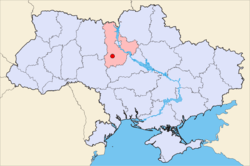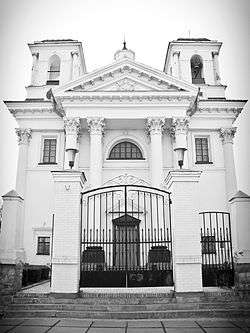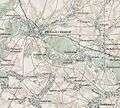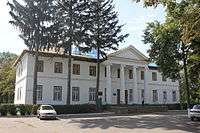Bila Tserkva
| Bila Tserkva Бiла Церква | |||
|---|---|---|---|
|
Collage of the views of Bila Tserkva, Top left:A view of Ros River and Tsentralnyy Bridge (Центральний міст), Top middle:Belotserkovsky National Agrarian University (Білоцерківський національний аграрний університет), Top right:The Heroes Hundreds of Heaven Street (Вулиця Героїв Небесної Сотні), Bottom upper left:Kurbas Market Mall, Bottom lower left:Colonnade Echo (Колонада «Луна»), Bottom right:Panoramic view of Bila Tserkva with Torhova Square | |||
| |||
 | |||
 Bila Tserkva Location of Bila Tserkva | |||
| Coordinates: 49°47′56″N 30°06′55″E / 49.79889°N 30.11528°ECoordinates: 49°47′56″N 30°06′55″E / 49.79889°N 30.11528°E | |||
| Country | Ukraine | ||
| Oblast | Kiev Oblast | ||
| Raion | Bila Tserkva City Municipality | ||
| Founded | 1032 | ||
| Magdeburg Rights | 1589 | ||
| Government | |||
| • Head of City Council | Vasyl Savchuk | ||
| Area | |||
| • Total | 34.77 km2 (13.42 sq mi) | ||
| Elevation | 148 m (486 ft) | ||
| Population (2015) | |||
| • Total | 211,100 | ||
| • Density | 6,100/km2 (16,000/sq mi) | ||
| Postal code | 09100-09117 | ||
| Area code(s) | (+380) 4563 | ||
| Vehicle registration | AI/10 | ||
| Sister cities | Barysaw, Jingzhou, Kaunas, Ostrowiec Świętokrzyski, Noginsk, Kremenchuk | ||
| Website | http://www.bilatserkva.info/ | ||
Bila Tserkva (Ukrainian: Бі́ла Це́рква (Ukrainian pronunciation: [ˈbʲiɫɑ ˈt͡sɛrkwɑ]), Polish: Biała Cerkiew, Russian: Белая Церковь, Belaya Tserkov, literally White Church) is a city in central Ukraine, the largest city in Kiev Oblast.[1] Bila Tserkva is located on the Ros River approximately 80 km (50 mi) south of Kiev. The area is 34 km2 (13 sq mi).[2] Population: 210,919 (2013 est.)[3].
Administratively, Bila Tserkva is incorporated as a town of oblast significance. It also serves as the administrative center of Bila Tserkva Raion (district), though administratively it does not belong to the raion.
History
The town was founded in 1032 as Yuriev by Yaroslav the Wise, whose Christian name was Yuri. This event is also traditionally referred as foundation of Tartu, Estonia. The present name of the city, literally translated, is "White Church" and may refer to the (no longer existing) white-painted cathedral of medieval Yuriev. Since 1363 it belonged to the Grand Duchy of Lithuania, and since 1569 to the Polish-Lithuanian Commonwealth. Was granted Magdeburg Rights in 1620 by Sigismund III Vasa.
The Treaty of Bila Tserkva between the Polish-Lithuanian Commonwealth and Ukrainian Cossack rebels under Bohdan Khmelnytsky was signed here in 1651.[4]
Beginning in the second half of the 18th century, Bila Tserkva (Biała Cerkiew), then the seat of the sub-prefecture (starostwo), was the property of the Branicki family. Franciszek Ksawery Branicki, Poland's Grand Hetman, built there his urban residence – the Winter Palace complex and a country residence with the park "Alexandria" (named after his wife). He founded a Catholic church of John the Baptist and started construction of the Orthodox church which was completed by his successor – count Władysław Grzegorz Branicki. The latter one built also the gymnasium-school complex in Bila Tserkva. Aleksander Branicki, the grandson of the hetman, renovated and finished the Mazepa's Orthodox church. Under the rule of count Władysław Michał Branicki, Bila Tserkva developed into a regional commercial and manufacturing centre.[5][6]
Bila Tserkva was annexed into Russian Empire as a result of the Second Partition of Poland in 1793.
After 1861, the Tzarist authorities converted the Roman Catholic church into an Orthodox Church.[7] During the Soviet times Bila Tserkva became a large industrial hub (machine building and construction industry).
During World War II, Bila Tserkva was occupied by the German Army from 16 July 1941 to 4 January 1944.[8] In August 1941 it was the site of the 1941 Bila Tserkva massacre.
During the Cold War, the town was host to the 72nd Guards Krasnograd Motor Rifle Division[9] and the 251st Instructor Heavy Bomber Aviation Regiment of Long Range Aviation.[10]
Sights

Notable buildings include the merchant court (1809–1814) and the complex of post buildings (1825–31). There are also Palladian wooden buildings of the Branickis' "Winter Palace" and the district nobility assembly. The church of St. Nicholas was started in 1706 but was not completed until 1852. The Orthodox cathedral of the Saviour's Transfiguration was constructed in 1833–1839, while the Catholic Church of John the Baptist dates to 1812.
A historical landscape park "Alexandria" of 2 km2 (0.77 sq mi) is situated in Bila Tserkva. It was founded in 1793 by the wife of the Polish hetman Franciszek Ksawery Branicki.
Activities
The city is home to football team FC Ros' Bila Tserkva. Ros is a team in the lower levels of the Ukrainian Football League.
Industry in the city includes Railway Brake product manufacturers "Tribo Rail", "Bilotserkivsky Zavod Tribo Ltd" and the major automobile tire manufacturer "Rosava".
Famous people
- Lyudmila Pavlichenko – World War II Soviet sniper. Credited with 309 kills, she is regarded as one of the top military snipers of all time and the most successful female sniper in history.
- David Bronstein – leading chess grandmaster and writer
- Volodymyr Dyudya – Ukrainian cyclist
- David Goodman, father of Benny Goodman – an American jazz and swing musician, clarinetist and bandleader; widely known as the "King of Swing"
- Andrzej Klimowicz – Zegota underground activist, Righteous Among the Nations
- Vadim Lazarkevich – Russian–Bulgarian illustrator
- Yuri Linnik – Soviet mathematician
- Olexandr Medvid' – famous Soviet/Belarusian wrestler.
- Yossele Rosenblatt – renowned American cantor
- Shaye Shkarovsky - Yiddish author
- Anna Ulitko – Danish natural scientist
- Lyudmila Usherovitz (Ayzenberg Married);– Jewish gymnast
- Shmuel Yerushalmi – Israeli protest poet
- Yuriy Zagorodniy – footballer
- Yaroslav Koposov – Ukrainian musician
Twin towns – sister cities
Gallery
.jpg) Merchant court in Bila Tserkva
Merchant court in Bila Tserkva_3.jpg) Former post office
Former post office- St. Nicholas church
- Church of Transfiguration
 Bila Tserkva National Agrarian University
Bila Tserkva National Agrarian University Bila Tserkva, Oleksandriia, and surrounding villages in 1889
Bila Tserkva, Oleksandriia, and surrounding villages in 1889 View of the so-called Ruins and the Laznevogo lake of the historical landscape park "Alexandria".[12]
View of the so-called Ruins and the Laznevogo lake of the historical landscape park "Alexandria".[12] Branicki Winter Palace
Branicki Winter Palace Water tower
Water tower Organ Hall
Organ Hall Square before the fall of Lenin monument in 2014
Square before the fall of Lenin monument in 2014._%D0%92%D1%85%D1%96%D0%B4.jpg) Gates of Taras Shevchenko Park
Gates of Taras Shevchenko Park Railway station
Railway station- St. Mary Magdalene church
See also
References
- ↑ (after Kiev which is the administrative center, but not part of the oblast)
- ↑ General information about the city, at Bila Tserkva official web-site
- ↑ "Чисельність наявного населення України (Actual population of Ukraine)" (in Ukrainian). State Statistics Service of Ukraine. Retrieved 21 January 2015.
- ↑ Paul Robert Magocsi, A history of Ukraine, University of Toronto Press, 1996, p. 205
- ↑ E. A. Chernecki, L. P. Mordatenko, Bila Tserkva. Branicki family. Alexandria, Ogrody rezydencji magnackich XVIII-XIX wieku w Europie Środkowej i Wschodniej oraz problemy ich ochrony, Ośrodek Ochrony Zabytkowego Krajobrazu—Narodowa Instytucja Kultury, 2001, p.114
- ↑ Marek Ruszczyc, Dzieje rodu i fortuny Branickich, Delikon, 1991, p. 148
- ↑ Lucjan Blit, The origins of Polish socialism: the history and ideas of the first Polish Socialist Party 1878–1886, Cambridge University Press, 1971, p. 21
- ↑ Onwar.com, Allies support resistance in Europe
- ↑ Carey Schofield, Inside the Soviet Army, Headline Book Publishing, 2001, 132.
- ↑ Michael Holm, 251st Instructor Heavy Bomber Aviation Regiment, accessed December 2012.
- ↑ "Miasta Partnerskie". Retrieved 1 May 2014.
- ↑ For more images of the park "Alexandria", see klymenko.data-tec.net
External links
| Wikisource has the text of the 1911 Encyclopædia Britannica article Byelaya Tserkov. |
| Wikimedia Commons has media related to Bila Tserkva. |
- Fine and cheap hotel Kiev in the center of our city
- Four stars hotel Kiev in the center of our city
- Street Angels (UKRAINE) – Website of StreetRacers in Bila Tserkva
- Website of Bila Tserkva's patriots
- Informative Website of Bila Tserkva
- Old photos of Bila Tserkva
- Old photos of Alexandria park
- Official Bila Tserkva city webportal in Ukrainian
- Enterprise catalogue of Bila Tserkva
- Latest news in our city
- Sightseeings of Bila Tserkva
- History of Jewish Community in Belaya Tserkov


